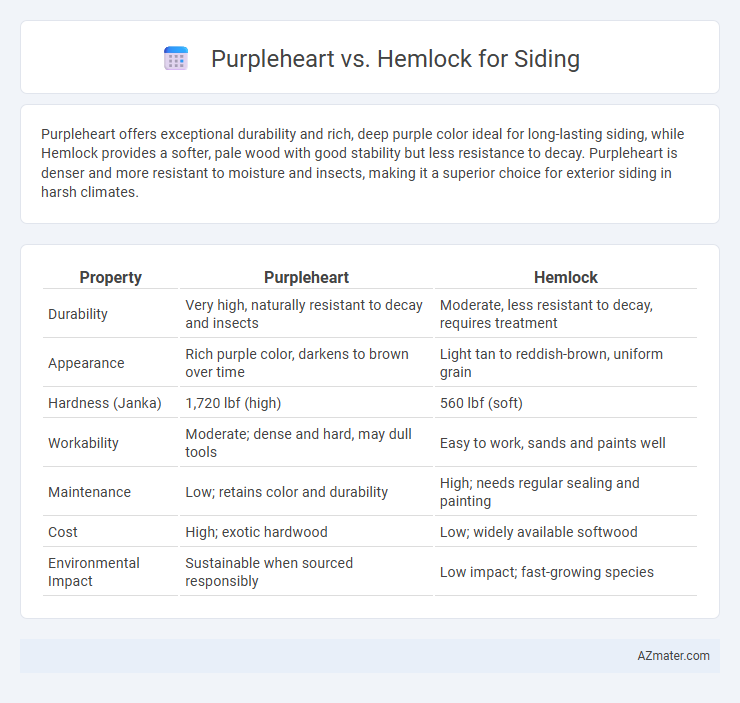Purpleheart offers exceptional durability and rich, deep purple color ideal for long-lasting siding, while Hemlock provides a softer, pale wood with good stability but less resistance to decay. Purpleheart is denser and more resistant to moisture and insects, making it a superior choice for exterior siding in harsh climates.
Table of Comparison
| Property | Purpleheart | Hemlock |
|---|---|---|
| Durability | Very high, naturally resistant to decay and insects | Moderate, less resistant to decay, requires treatment |
| Appearance | Rich purple color, darkens to brown over time | Light tan to reddish-brown, uniform grain |
| Hardness (Janka) | 1,720 lbf (high) | 560 lbf (soft) |
| Workability | Moderate; dense and hard, may dull tools | Easy to work, sands and paints well |
| Maintenance | Low; retains color and durability | High; needs regular sealing and painting |
| Cost | High; exotic hardwood | Low; widely available softwood |
| Environmental Impact | Sustainable when sourced responsibly | Low impact; fast-growing species |
Introduction to Purpleheart and Hemlock as Siding Materials
Purpleheart is a dense, hardwood known for its rich purple hue and exceptional durability, making it a striking and long-lasting choice for siding. Hemlock, a softwood with a pale, straight grain, offers a more affordable and lightweight option with good resistance to decay when properly treated. Both materials provide distinct aesthetic and performance qualities, with Purpleheart excelling in strength and color, while Hemlock delivers cost-effectiveness and ease of installation for siding applications.
Physical Properties Comparison: Purpleheart vs Hemlock
Purpleheart wood exhibits exceptional density, hardness rating around 2,200 on the Janka scale, and high natural resistance to decay, making it ideal for durable siding applications. Hemlock, with a lower density and Janka hardness near 540, is softer and less durable but easier to work with and more cost-effective for siding projects. Purpleheart's superior strength and weather resistance provide longer-lasting exterior siding compared to Hemlock, which may require additional maintenance.
Durability and Lifespan
Purpleheart wood boasts exceptional durability with a lifespan of 25 to 40 years when used for siding due to its high natural oil content and resistance to decay, insects, and rot. Hemlock, while moderately durable, typically lasts 15 to 20 years and requires regular maintenance and treatment to prevent moisture damage and insect infestation. The dense grain and natural resilience of Purpleheart make it a superior choice for long-lasting, low-maintenance exterior siding applications.
Resistance to Weather and Insects
Purpleheart wood exhibits exceptional resistance to weather and insects, making it a durable choice for siding in harsh climates due to its dense, oily composition that naturally repels moisture and pests. Hemlock, while moderately resistant to decay, is more susceptible to insect damage and weathering, requiring protective treatments to enhance its longevity in exterior applications. For siding exposed to extreme weather and insect pressure, Purpleheart offers superior performance with minimal maintenance compared to Hemlock.
Workability and Installation
Purpleheart wood offers excellent workability due to its fine grain and moderate hardness, allowing for smooth cutting and shaping during siding installation. Hemlock, while softer and easier to nail, can splinter more easily, requiring careful handling to maintain its surface integrity. Both woods provide solid options, but Purpleheart's durability and precision in machining often result in a cleaner, longer-lasting siding application.
Aesthetic Appeal and Color Changes
Purpleheart siding offers a rich, vibrant purple hue that deepens to a warm brown with extended UV exposure, creating a striking and unique facade. Hemlock siding displays a light reddish-brown color that weathers to a soft silver-gray over time, providing a natural, rustic look appealing for traditional architectural styles. Both woods enhance curb appeal, but Purpleheart delivers a bold aesthetic, while Hemlock offers subtle, aging character through color changes.
Environmental Impact and Sustainability
Purpleheart siding, sourced from the sustainably managed forests of Central and South America, offers a high durability with minimal chemical treatment, reducing environmental toxins during production and installation. Hemlock, often harvested from North American forests, varies in sustainability depending on certification, with FSC-certified Hemlock ensuring responsible forestry practices that protect biodiversity and soil health. Both woods provide renewable options, but Purpleheart's natural resistance to decay extends siding lifespan, lowering replacement frequency and overall environmental footprint.
Maintenance Requirements
Purpleheart siding demands minimal maintenance due to its natural oil content, which enhances durability and resistance to rot and insect damage, reducing the need for frequent sealing or treatments. Hemlock siding requires more regular upkeep, including periodic staining or sealing to protect against moisture and pest intrusion, as it is less naturally resistant to decay. Choosing Purpleheart ensures lower long-term maintenance costs and sustained aesthetic appeal with less effort.
Cost Analysis
Purpleheart siding typically costs between $12 to $18 per square foot due to its rarity and dense hardwood properties, making it a premium option with excellent durability and resistance to decay. Hemlock siding, priced around $5 to $8 per square foot, offers a more budget-friendly alternative with moderate durability but requires more frequent maintenance to mitigate rot and insect damage. The significant price difference reflects Purpleheart's superior longevity and weather resistance, often leading to lower long-term replacement and maintenance expenses despite higher initial investment.
Best Applications and Recommendations
Purpleheart wood offers exceptional durability and vibrant coloration, making it ideal for decorative siding where aesthetic appeal and weather resistance are priorities. Hemlock, being more affordable and easier to work with, suits structural siding applications or areas where a consistent, smooth finish is required but extreme durability is less critical. For exterior siding exposed to harsh weather, Purpleheart is the recommended choice, while Hemlock is preferable for interior or sheltered siding projects.

Infographic: Purpleheart vs Hemlock for Siding
 azmater.com
azmater.com